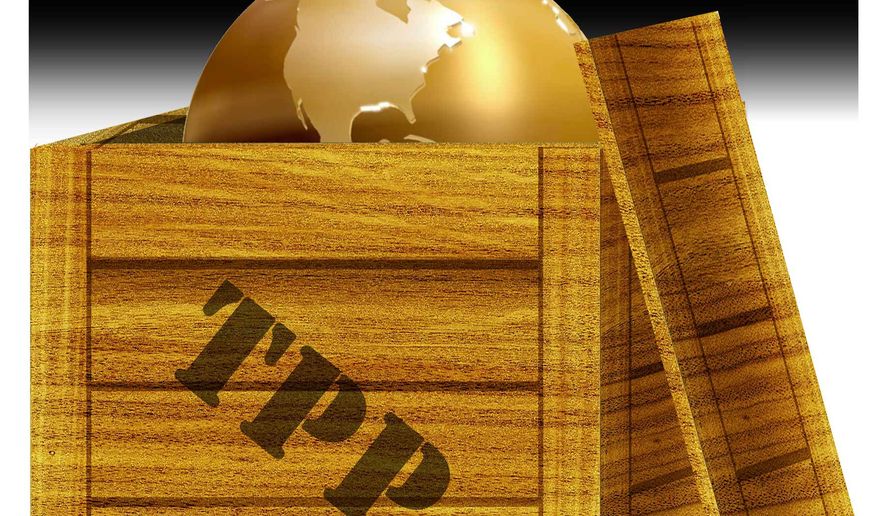OPINION:
Congress has passed three of the worst trade deals in history — 1993’s NAFTA, China’s 2001 entry into the World Trade Organization, and the 2012 South Korean agreement. Each time, we were assured by the White House and elite globalist think tanks these deals would create thousands of jobs, increase wages, and strengthen our manufacturing base. Each time, the deals have hemorrhaged jobs, depressed wages, and ballooned America’s trade deficit.
Just what is going so very wrong here? This is an important question because the White House and its think tank enablers are now pressing hard to pass what may well be the worst trade deal yet, the Trans-Pacific Partnership (TPP).
To answer this question, let’s examine the forecasting model much of Washington depends upon. Let’s also identify two of the main players in the trade modeling game, the government’s International Trade Commissionand the influential Peterson Institute think tank.
The “Computational General Equilibrium” (CGE) forecasting model created by the International Trade Commission is also used by Peterson’s economists. According to a Tufts University study, the CGE/Peterson model creates an inherent bias toward bad trade deals. This bias is indeed quickly revealed by the model’s three deeply flawedassumptions.
First, the CGE model assumes the unemployment rate stays at or below 4 percent for 15 consecutive years. Thus, if Ford moves its small car production from Michigan to Mexico, thousands of laid off American workers instantaneously find work elsewhere.
Second, the model assumes a constant income share between capital and labor. So when shareholders benefit from the offshoring of America’s factories through higher profits and rising stock prices, laid-off American workers will somehow benefit too — a cruel “let them eat cake” joke.
Third, and most absurdly, the model assumes our trade deficit will not change from its current level. Since NAFTA went into effect in 1993, the deficit with Mexico has risen from near zero to $60 billion. Since China joined the WTO in 2001, the China deficit in goods has risen nearly ten-fold annually, from $83 billion to $367 billion.
To see how destructive the failed predictions of the CGE/Peterson model have been to America, consider the 2012 South Korean agreement. Secretary of State Hillary Clintoncalled it a “cutting edge” deal that would create 70,000 new jobs while a Peterson economist promised “big net gains for both sides.” Instead, the United States has lost 95,000 jobs, the South Korea trade deficit has roughly doubled, and America’s Michigan-centered auto industry has been hit particularly hard.
Peterson economists also said NAFTA would create 171,000 jobs; instead, we’ve lost 850,000. They claimed China’s entry into the World Trade Organization in 2001 “costs the United States practically nothing.” The true cost: The loss of over 50,000 factories, more than 5 million jobs, and stagnant wages for the last 15 years.
Undaunted by these forecasting failures, President Obama describes the Trans-Pacific Partnership as “the most progressive” agreement in history while Peterson’s economists say it will add 796,000 jobs in exporting activity and increase real incomes by $131 billion.” Peterson economists direly warn delaying TPP by just one year would result in a “$77 billion permanent loss.”
This is not the only modeling mischief afoot. Peterson’s Chicken Little wing is also warning that Donald Trump’s plan to stop our trading partners from engaging in unfair trade practices will “unleash a trade war that would plunge the economy into recession.”
This globalist spin by think tanks like Peterson is nothing short of “idea laundering.” This is a term coined by Alan Tonelson to describe the dressing up of special interest pleadings in the Potemkin garb of academic and intellectual objectivity.
In sharp contrast, the Tufts University modelers favor the more flexible and realisticUnited Nations Global Policy Model. They forecast a TPP loss of 448,000 U.S. jobs — even as the worker share of the U.S. economy falls by 1.31 percent. Critically, the Tufts research shows the TPP will significantly harm American manufacturing, a conclusion even the Peterson Institute does not refute.
For more than a year and a half, the Obama administration has refused to answer even these most basic questions: Will the TPP increase wages? Will it reduce our trade deficit? Given that the CGE/Peterson model assumes away these harms, it hides the true results from the American people.
Americans are fed up with trade agreements that fail to deliver the promised results. Caddell & Associates have found by a wide margin, Americans believe our free trade deals have benefited other countries more than the United States. A PEW poll recently found that “eight-in-ten adults say increased outsourcing of jobs to other countries hurts American workers.”
It is poll results like these that are propelling the candidacy of change agents like Donald Trump. This groundswell of discontent should be a warning to the White House not to take this country down yet another rabbit hole of globalism on the bad advice of idea laundering think tanks.
• Jeff Sessions is a Republican U.S. senator from Alabama. Peter Navarro is a business professor at the University of California -Irvine and a senior policy adviser to Donald Trump.




Please read our comment policy before commenting.